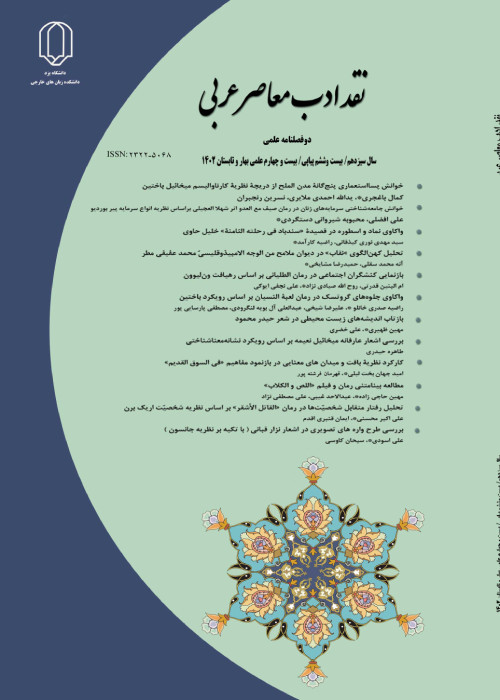Analysing the Characters in the Play "Mulham al-Sarab" by Sadullah Venus Based on Shalomite Raymond Kenan's View
In literature, the creation of a character is the product of the thoughts and ideas of the author who creates it inspired by his or her environment and time. The concept of character, like other phenomena in the world of art, has always undergone changes over time and the ups and downs of human life (Daghighian, 1992). Regarding the background of personality and characterization, Aristotle was the first to speak about it. About the relationship between personality and action, he believes that personality is a constant companion of action (Abu Shahab, 2008). Drama is an important type of story in which the author conveys his thoughts to the audience and deals with the issues and problems in the society and criticizes it through the characters. Characterization is one of the most important topics in the field of fiction; therefore, contemporary writers pay special attention to this issue in their works. One of these writers, Saadullah Venus, a well-known Syrian playwright, has paid more attention to character than to the other narrative elements and has used different personality types in his play entitled "Mulham al-Sarab". Using these characters, he recounts the problems of Arab countries, including his homeland Syria. Shalomite Raymond Kenan, one of the contemporary critics and writers, has dealt with the subject of personality in detail in his narrative book Contemporary Poetics. According to him, character is a construction that the reader makes by combining different signs scattered throughout the text (Kenan, 2008). The author examines the characteristics of the characters with various indicators and patterns in the story. This theory is divided into direct and indirect descriptions. In direct description, character traits are introduced with an adjective or possibly some types of nouns or components of speech (ibid). In contrast, indirect description deals with action based on habitual and non-habitual approaches. The action also deals with the result as well as the speech, the environment, the appearance and the analogy between the characters.
Through the descriptive-analytical method and with the aim of examining the main and minor characters of the play "Malhamah al-sarab" based on Raymond Kenan's theory, this study seeks to detect the thoughts and ideas of Sadollah Venus.
Direct description: The description of personality characteristics is considered as direct characterization when the most authentic voice of the text conveys it to the reader (ibid). In this description, the character is personified directly and briefly using an adjective or a noun. The determination of names for characters is a special type of direct description (Lotte, 2007).
Indirect description: In this kind of description, the author presents and describes a characteristic in different ways instead of referring to the character. The use of action and behavior as the first and simplest role of a character is important because it determines the development of characters in a story (Habibi et al., 2016). Nowadays, most writers use this type of description to introduce characters. Since explicit and guiding ability of direct description is often considered as a disadvantage, they believe in that while they are fully aware of the audience and know that not involving the minds of people and just considering them as bystanders makes them bored (Kenan, 2008). Raymond Kenan has introduced several different indicators to use this type of description;
A) Action: Action refers to the behavior of the characters throughout the story, "to what has been done, has not been done or is going to be done" (Ashrafi and Taki, 2018: 10). This tool in the story is divided into two types of habitual actions and non-habitual actions (Kenan, 1995). Habitual action is an action that is repeated regularly (Okhovat, 1992), but unusual action is that it happens only once and, in the light of it, the spirit of the character can be understood (ibid).
B) Speech: Another characteristic of indirect description stands for what one character says about another character (Kenan, 2008). Speech can reveal the social or professional class of a character (Kennan, 1995).
C) Physical description: This type of description can refer to the character's face. It sometimes speaks of character and sometimes the narrator reveals its relationship with the character (ibid).
D) Physical environment: The environment around the character (room, house and city) is among the things that indicate the character's traits. The human environment around him or her (family, social class) indicates the personality characteristics (Kenan, 2008).
E) Analogy of persons: The analogy of people is used when two characters are introduced in similar situations and the similarity or contradiction between their behavior is emphasized (ibid).
The results of the study of the play "Malhamah al-Sarab" based on the theory of Raymond Kenan indicate that the author of this play expresses the character of Abboud and his characteristics in the form of direct descriptions to begin the story and uses indirect descriptions to introduce the other characters. Moreover, in this play, the role of indirect description is more important than the direct description, and the indicators of performance or non-performance of roles and actions by characters such as Abboud, Yassin, Sheikh Abbas and the others are reflected in the play. Also, among the methods of indirect description, environment and speech are more prominent than other patterns of rhymes. Venus advances the play in different environments to provide an accurate and clear picture of the economic and social situation of the rural community. He also uses the speech indicator to express the emotions and feelings of the characters. Finally, Venus draws an analogy of the individuals using the historical characters of Abel and Cain, which shows the author's success in using the analogical model to express the anomalies that rule the society.
- حق عضویت دریافتی صرف حمایت از نشریات عضو و نگهداری، تکمیل و توسعه مگیران میشود.
- پرداخت حق اشتراک و دانلود مقالات اجازه بازنشر آن در سایر رسانههای چاپی و دیجیتال را به کاربر نمیدهد.



